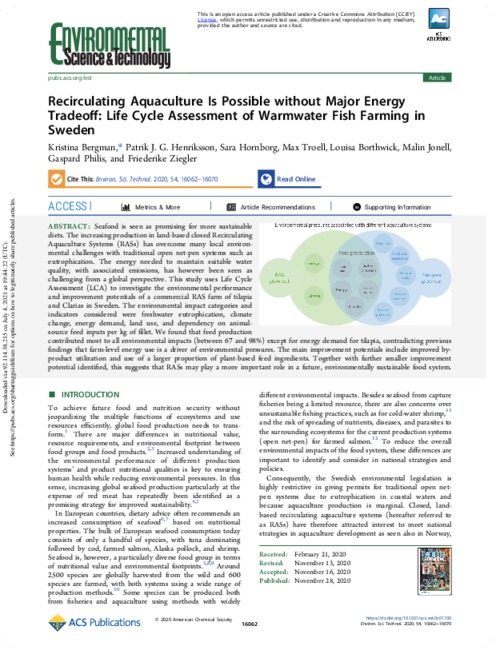Please use this identifier to cite or link to this item:
https://hdl.handle.net/20.500.12348/4760
Recirculating Aquaculture Is Possible without Major Energy Tradeoff: Life Cycle Assessment of Warmwater Fish Farming in Sweden
| dc.creator | Bergman, K. | en_US |
| dc.creator | Henriksson, P.J. | en_US |
| dc.creator | Hornborg, S. | en_US |
| dc.creator | Troell M. | en_US |
| dc.creator | Borthwick, L. | en_US |
| dc.creator | Jonell, M. | en_US |
| dc.creator | Philis, G. | en_US |
| dc.creator | Ziegler, F. | en_US |
| dc.date.accessioned | 2021-07-04T20:19:13Z | |
| dc.date.available | 2021-07-04T20:19:13Z | |
| dc.identifier.citation | Recirculating Aquaculture Is Possible without Major Energy Tradeoff: Life Cycle Assessment of Warmwater Fish Farming in Sweden Kristina Bergman, Patrik J. G. Henriksson, Sara Hornborg, Max Troell, Louisa Borthwick, Malin Jonell, Gaspard Philis, and Friederike Ziegler Environmental Science & Technology 2020 54 (24), 16062-16070 DOI: 10. 1021/acs. est. 0c01100. | en_US |
| dc.identifier.issn | 1520-5851 | en_US |
| dc.identifier.uri | https://hdl.handle.net/20.500.12348/4760 | |
| dc.description.abstract | Seafood is seen as promising for more sustainable diets. The increasing production in land-based closed Recirculating Aquaculture Systems (RASs) has overcome many local environmental challenges with traditional open net-pen systems such as eutrophication. The energy needed to maintain suitable water quality, with associated emissions, has however been seen as challenging from a global perspective. This study uses Life Cycle Assessment (LCA) to investigate the environmental performance and improvement potentials of a commercial RAS farm of tilapia and Clarias in Sweden. The environmental impact categories and indicators considered were freshwater eutrophication, climate change, energy demand, land use, and dependency on animal-source feed inputs per kg of fillet. We found that feed production contributed most to all environmental impacts (between 67 and 98%) except for energy demand for tilapia, contradicting previous findings that farm-level energy use is a driver of environmental pressures. The main improvement potentials include improved by-product utilization and use of a larger proportion of plant-based feed ingredients. Together with further smaller improvement potential identified, this suggests that RASs may play a more important role in a future, environmentally sustainable food system. | en_US |
| dc.format | en_US | |
| dc.language | en | en_US |
| dc.publisher | American Chemical Society | en_US |
| dc.rights | CC-BY-4.0 | en_US |
| dc.source | Environmental Science and Technology;54 ,(2020) Pagination 16062,16070 | en_US |
| dc.subject | animal derived food | en_US |
| dc.subject | Fish | en_US |
| dc.title | Recirculating Aquaculture Is Possible without Major Energy Tradeoff: Life Cycle Assessment of Warmwater Fish Farming in Sweden | en_US |
| dc.type | Journal Article | en_US |
| cg.contributor.crp | Fish | en_US |
| cg.coverage.country | Sweden | en_US |
| cg.coverage.region | Northern Europe | en_US |
| cg.subject.agrovoc | aquaculture | en_US |
| cg.subject.agrovoc | energy | en_US |
| cg.subject.agrovoc | animal feed | en_US |
| cg.subject.agrovoc | electrical energy | en_US |
| cg.contributor.affiliation | WorldFish | en_US |
| cg.contributor.affiliation | The University of Tokyo | en_US |
| cg.contributor.affiliation | University of Pisa, Department of Agricultural, Food and Environment | en_US |
| cg.contributor.affiliation | RISE Research Institutes of Sweden | en_US |
| cg.contributor.affiliation | Stockholm Resilience Centre | en_US |
| cg.contributor.affiliation | Beijer Institute of Ecological Economics | en_US |
| cg.contributor.affiliation | Norwegian University of Science and Technology | en_US |
| cg.identifier.status | Open access | en_US |
| cg.identifier.ISIindexed | ISI indexed | en_US |
| cg.description.theme | Sustainable aquaculture | en_US |
| dc.identifier.doi | https://dx.doi.org/10.1021/acs.est.0c01100 | en_US |
| cg.creator.id | Patrik John Gustav Henriksson: 0000-0002-3439-623X | en_US |
Files in this item
This item appears in the following Collection(s)
-
Sustainable aquaculture [2735]
